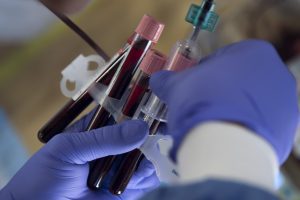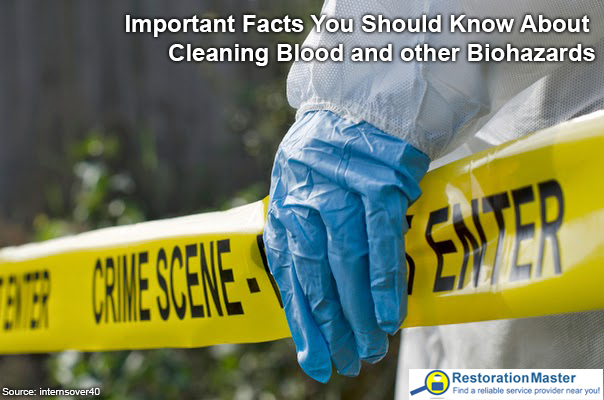Facts You Should Know About Biohazard and Crime Scene Cleanup
Biohazard cleanup is linked to instances of death, such as suicide and murder, or accidents, injuries and trauma. Cleaning up the scene requires more than a strong stomach; it requires professional equipment, following the US Occupational Safety and Health Administration (OSHA) standards and disposing the waste, including blood, bodily fluids and body tissue, safely.
Biohazard waste can be primarily identified as follows:
- Human or animal blood or tissue
- Human or animal body parts
- Bodily fluids
- Paper towels, rags and similar items saturated with biohazardous materials
- Infectious agents
- Waste from bacteria, sporesSpores are microscopic reproductive units of fungi or mold t... More and virusesViruses are microscopic infectious agents that can only repr... More
Following are seven facts relevant to biohazard and crime scene cleaning:
Fact #1: Certification Is NOT Required to Clean Crime Scenes
A license or certification is not required to begin the cleanup process of a crime scene. However, OSHA requires that employers and employees involved in the cleanup of blood and other infectious materials follow its Blood borne PathogensPathogens are microorganisms such as bacteria, viruses, or f... More standard (BBP). OSHA’s standard protects employees who would be exposed to blood and blood borne pathogensPathogens are microorganisms such as bacteria, viruses, or f... More. Many employers offer on-the-job training for individuals interested in biohazard cleanup responsibilities.
Fact #2: Biohazard Waste Must Be Disposed of Properly
Human blood and bodily fluids can potentially cause infections, even up to a few weeks after having spilled onto environmental surfaces. The hepatitis B virus (HBV), for instance, has been known to survive for over two weeks, and the hepatitis C virus can be infectious for up to two weeks.
Due to the presumption that blood pathogensPathogens are microorganisms such as bacteria, viruses, or f... More can pose as a threat to public health and the environment, all biohazard materialsBiohazard materials are substances that pose a risk to human... More must be disposed of by a licensed biohazard waste hauler and in accordance to federal, state and local laws.
Fact #3: Even Minor Blood Stains Are Harmful
Treat all blood, no matter how insignificant, with caution. Even the smallest droplets of blood may contain harmful pathogensPathogens are microorganisms such as bacteria, viruses, or f... More that carry infectionInfection is the invasion and multiplication of harmful micr... More. Blood spilt onto the carpet is likely to soak into the floorboards beneath, compounding the potential spread of disease; blood can also become airborne and contaminate the environment. Odors from blood can linger and become an unsanitary presence.
Even if you are familiar with the person whose blood has been shed, it is important to proceed with caution. Harmful bacteria that you may be unaware of can reside within the blood. At best, avoid all contact with any and all blood spills.
Fact #4: Blood Borne PathogensPathogens are microorganisms such as bacteria, viruses, or f... More Taint Human Health

Blood Borne PathogensPathogens are microorganisms such as bacteria, viruses, or f... More Taint Human Health
As mentioned, it is estimated that 1 out of every 24 people are plagued with the hepatitis B, hepatitis C or HIV virus at any given time. When an individual with an infectionInfection is the invasion and multiplication of harmful micr... More of this type dies, the pathogensPathogens are microorganisms such as bacteria, viruses, or f... More for these diseases continue to survive.
Exposure to these blood borne pathogensPathogens are microorganisms such as bacteria, viruses, or f... More can result from direct contact, accidental mishaps due to biological fragments, inhalation and even splashes of blood or bodily fluid that can enter through one’s eyes, mouth and nose.
Fact #5: Police Do Not Clean Up a Crime Scene
While police officials and investigators will collect evidence from a crime scene, they will not perform cleanup services. Only professional crime scene specialists are adept at the task of removing harmful biological waste and blood borne pathogensPathogens are microorganisms such as bacteria, viruses, or f... More from the site.
Professional cleanup teams arrive onsite only after the law enforcement personnel have gathered sufficient proof related to the crime, so as not to disturb any evidence contained within the scene.
In addition, police and emergency medical technicians are not trained to handle the cleanup of biohazard waste materials. Only licensed biohazard cleanup professionals are equipped with the tools necessary to complete the cleanup process.
Fact #6: Biohazard Cleanup Teams Disinfect More Than Crime Scenes
Crime scenes, such as homicides and instances where severe bodily injuries have occurred, are typically cleaned up by biohazard cleanup teams equipped to handle the bloody chaos. However, the bulk of their work includes suicides and unattended deaths.
Fact #7: Licensed Biohazard Cleanup Services Offer At Least Three Qualifications

When an unfortunate accident or crime occurs on your property, call you local RestorationMaster team for most reliable biohazard and trauma scene cleanup services
An ordinary cleaning crew is untrained in the cleanup of biohazard materialsBiohazard materials are substances that pose a risk to human... More and crime scenes. The property affected by biohazard waste must be fully decontaminated to be habitable again.
When selecting a vendor to provide biohazard cleaning services, first make sure the company complies with all OSHA standards, not only with the Bloodborne PathogensPathogens are microorganisms such as bacteria, viruses, or f... More program. OSHA regulations that must be followed during the cleanup include Personal Protective Equipment, Hazard Communication and Heat Illness, among others.
A second factor to consider when choosing a biohazard cleaning company is to make sure the company is licensed to dispose of biohazard waste in accordance with local and state laws.
Thirdly, a reputable crime scene cleanup company trains its team to handle communications with sensitivity when working on the scene, which can be a family home or place of business. Typically, one person is assigned the task of updating family members and being the sole point of contact to eliminate confusion. The grief and sense of loss due to the trauma is handled with compassion by trusted crime scene cleanup specialists.












